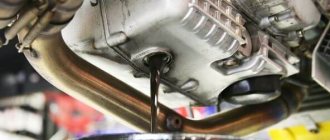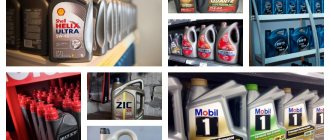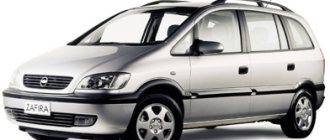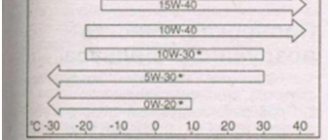OIL TECHNIQUE > Motor oil > Classification of motor oils
(votes: 11 , rating: 4.82 out of 5)
In this article we will look at different classification systems for motor oils. During the existence of internal combustion engines, a huge number of oils have been developed, differing both in quality and in scope and features of use. All this diversity required some kind of streamlining, for which different automotive organizations created standards that made it possible to classify oils depending on their properties and purpose. Using this information, you can easily select the right oil for a specific engine, based on the car manufacturer’s recommendations.
Here are the main classification systems for motor oils:
- first, of course, SAE J300 - classification of viscosity of motor oils
- API - classification of quality, or rather, performance characteristics of oil
- ACEA is a European classification that includes information about both the scope of application of the oil and its quality.
- ILSAC - Japanese-American oil performance rating system
- OEM approvals - requirements for automaker oils
- GOST 17479.1-85 - born in the USSR, but still valid to this day, the Russian standard for motor oils
As you can see, there are many different specifications, but the main three are: SAE, API and ACEA. Let's figure out what they are.
SAE Viscosity Classification
This classification of motor oils (by the way, transmission oils too) is described in detail in the article on motor oil viscosity. Here I will briefly say that it regulates (as has probably already become clear :)) the viscosity of motor oil in its three main states: when starting the engine (cold oil), during its normal operation (heated oil) and at high speeds and shear loads, so-called HTHS (overheated oil). On canisters, this classification is written xxW-yy (for example, 10W-40), where the first number characterizes the minimum necessary conditions for starting the engine in the cold season, and the second means viscosity during normal operation. Subsequently, the second number included requirements for working in “forced” mode. So to speak, two in one. In some cases, it is possible to use these numbers separately, for example, an oil with a viscosity of 20W and an oil with a viscosity of 30. Such oils are called seasonal (conventionally, “summer” and “winter”). The letter W means winter, “winter” in English. As I said, for comprehensive information on this classification system, read the article at the link given above.
Motor oil marking according to SAE
The most important characteristic that is indicated in the marking on the canister is the viscosity coefficient according to the SAE classification - this is an international standard regulating the viscosity of oils at plus and minus temperatures (limit value).
In accordance with the SAE standard, oils are designated in the XW-Y format, where X and Y are certain numbers. The first number is a symbol indicating the minimum temperature at which oil is normally pumped through the channels and the engine cranks without difficulty. The letter W stands for the English word Winter.
| Values | 0W | 5W | 10W | 15W | 20W | 25W |
| Cranking | -30°С | -25°С | -20°С | -15°С | -10°С | -5°C |
| Pumpability | -40°С | -35°С | -30°С | -25°С | -20°С | -15°С |
The second number conventionally means the minimum and maximum value of the high-temperature viscosity limit of the oil when it is heated to operating temperature (+100...+150°C). The higher the number, the thicker it is when heated, and vice versa.
| 5W - 30 | from minus 25 to plus 20 |
| 5W - 40 | from minus 25 to plus 35 |
| 10W - 30 | from minus 20 to plus 30 |
| 10W - 40 | from minus 20 to plus 35 |
| 15W - 30 | from minus 15 to plus 35 |
| 15W - 40 | from minus 15 to plus 45 |
| 20W - 40 | from minus 10 to plus 45 |
| 20W - 50 | from minus 10 to plus 45 and above |
| SAE 30 | from 0 to plus 45 |
Therefore, oils are necessarily divided into three types depending on the viscosity value:
- winter oils , they are more fluid and provide trouble-free engine starting in the cold season. The SAE indicator designation for such oil will contain the letter “W” (for example, 0W, 5W, 10W, 15W, etc.). To understand the limit value, you need to subtract the number 35. In hot weather, such oil is not able to provide a lubricating film and maintain the required pressure in the oil system due to the fact that at high temperatures its fluidity is excessive;
- summer oils are used when the average daily temperature is not lower than 0°C, since its kinematic viscosity is high enough so that in hot weather the fluidity does not exceed the required value for good lubrication of engine parts. At sub-zero temperatures, starting an engine with such a high viscosity is impossible. Summer brands of oils are designated by a numerical value without letters (for example: 20, 30, 40, and so on; the higher the number, the higher the viscosity). The density of the composition is measured in centistokes at 100 degrees (for example, a value of 20 indicates a limiting density of 8-9 centistokes at an engine temperature of 100 ° C);
- all-season oils are the most popular because they are capable of operating at both sub-zero and positive temperatures, the limit value of which is indicated in the SAE indicator. This oil has a double designation (example: SAE 15W-40).
When choosing an oil viscosity (from those approved for use in your car’s engine), you need to be guided by the following rule: the higher the mileage/older the engine, the higher the high-temperature viscosity of the oil should be.
Viscosity characteristics are the very first and most important element of the classification and labeling of motor oils, but not the only one - choosing an oil purely by viscosity is not correct . always necessary to choose the correct relationship between the properties of the oil and its operating conditions.
Each oil, in addition to viscosity, has a different set of operational properties (detergent, antioxidant properties, anti-wear, tendency to form various deposits, corrosiveness, and others). They allow us to determine the possible scope of their application.
API classification
This system characterizes differences in the performance characteristics of motor oils. It was invented by an organization called the American Petroleum Institute, which is reflected in the abbreviation. This classification contains two sections, according to the types of motor oils. Oils for gasoline engines are marked with the letter S (Service), and for diesel engines with the letter C (Commercial). There is an opinion that the letter S stands for spark, that is, ignition from a spark, and C stands for compression - ignition from compression. This version seems more reasonable to me, but the materials on the official API website clearly hint at the first option. It's a pity.
Next comes a letter indicating the corresponding performance characteristics (for example, SJ, SL, SM, or CD, CE, CF, and so on). The second letters change depending on the adoption of more stringent requirements for the quality of the oil; the closer to the end of the alphabet the letter, the better the oil. This is quite consistent with the chronological order of oil development. The first oils after the appearance of this classification of motor oils were labeled as SA and CA. They did not contain additives, accordingly, they had extremely low characteristics and were suitable for cars until approximately 1930 (it was in 1931 that additives began to be added to oils). By the way, you can read more about additives in the article about the composition of motor oil. It will become clear what makes up the high oil performance in operation.
As new standards are developed, previous ones are considered obsolete. For example, today (2015) the following gradations are relevant for gasoline engines:
- SN is the most modern gradation, introduced in October 2010. Provides today's best protection against high-temperature piston deposits, sludge formation, and compatibility with seal materials. Provides fuel economy and engine life savings, compatibility with exhaust emission control systems and protection for engines running on ethanol-containing fuel up to E85 (a grade of such fuel containing 85% ethanol and 15% gasoline). By the way, if anyone doesn’t know what oil does in a car, I recommend reading an article about the properties of motor oil.
- SM – for cars produced in 2010 and older.
- SL – for cars produced in 2004 and older.
- SJ – for cars produced in 2001 and older.
A more modern gradation level can be used instead of the previous ones.
For diesel engines:
- CJ-4 is the most modern gradation, also introduced in 2010.
- CI-4 - for vehicles produced in 2002 and older. Meets the 2004 requirements for the content of harmful substances in exhaust gases.
- CH-4 – for vehicles produced in 1998 and older.
All other gradations are outdated and can be easily replaced with current ones in older cars.
Basically, the motor oils produced are universal and can be easily used in both gasoline and diesel engines. In this case, both gasoline and diesel API gradations are indicated on the oil label through a fraction (for example, API SN/CF), and the gradation of the main purpose of the oil - gasoline or diesel - is indicated in the first place. Accordingly, if the oil is designed for only one type of engine, then the specification is written only for this type.
On oils certified by API you can see these icons, which indicate the class (or you may not see it, this is an optional attribute).
Yes, someone is probably interested in the question, what is the number 4 in the designation CI-4 and others? This means that the oil is suitable for a four-stroke diesel engine. Accordingly, there are oils for two-stroke diesel engines, however, they have only one class - CF-2 (well, it also had a predecessor CD-II, but this is the topic of a separate “chewing” article on the API classification, for the “enthusiasts” so to speak:)).
ACEA classification
The standards discussed above were “born and raised” in America, which may seem strange, since cars were invented in Europe. So at some point (namely in 1972), it occurred to the Europeans to create an organization that would regulate the automotive industry by issuing various standards. This organization was hiding behind the abbreviation CCMC (from the French Comité des Constructeurs du Marché Commun - Committee of Car Manufacturers of the Common Market, something like that). The logic for issuing oil standards was the same as that of the API; with each improvement in the various qualities of motor oils, another number was added to the letters G (gasoline engines), D (diesel engines) and PD (passenger car diesels). And the old ones were gradually recognized as obsolete. All these legends of deep antiquity interest us insofar as it was on the basis of this organization that the Association of European Automobile Manufacturers was born in 1996 (again from the French Association des Constructeurs Européens d'Automobiles - ACEA). It is the classification of this organization that interests us, since any oil producer that cares about its reputation will undergo certification of its products by ACEA and put the appropriate designations on the jars, which, by the way, look, for example, like this: A3/B4, A1/B1, C3 , E6 and so on...
So, the ACEA classification of motor oils includes four sections, designated by different letters:
- A – oils for gasoline engines
- B – oils for diesel engines of passenger cars and small commercial vehicles
- C – oils with reduced content of ash-forming elements
- E – oils for heavy commercial trucks
In 1996, the letter A replaced the letter G from the CCMC standard, and the letter B replaced the PD classification (diesel cars and small trucks, remember?). Until 2004, these letters (and the oils classified by them) existed separately, but since October 25, 2004 they were combined into several combinations of the type Ax/By, which implies their universal use. I will give the current designations for 2012 (there are specifications for 2014, but at the moment they are not posted on the official ACEA website, accordingly, they do not exist :)):
A1/B1 are multi-grade oils with extended drain intervals for gasoline and diesel engines, whose design involves the use of low-viscosity oils with an HTHS parameter of 2.6 mPa*s for viscosity xW-20 and from 2.9 to 3.5 mPa*s for all other viscosities. The possibility of using such oils must be expressly indicated in the documentation for the machine/engine, otherwise their use may result in engine damage. If anyone doesn’t understand what HTHS is, I recommend reading the article on motor oil viscosity. Everything is described there in quite detail.
A3/B3 – all-season oils for highly loaded gasoline and diesel engines and/or with the possibility of an extended replacement period, where provided by the engine manufacturer, and/or year-round use of low-viscosity oil, and/or severe operating conditions in accordance with the recommendations of the automaker. As you can see, the wording is quite vague (let me remind you, this is a translation of text from an official document). If we translate it loosely and briefly, then this is ordinary oil that is poured into cars that do not have recommendations for the use of other classes.
A3/B4 - almost the same as the previous point, plus use for diesel engines with direct injection. Accordingly, it easily replaces the previous paragraph and is more preferable than it. Not everyone clearly understands whether they have a diesel engine with direct injection or not :).
A5/B5 – multi-grade oils with extended drain intervals for heavily loaded gasoline and diesel engines, whose design is designed for the use of low-viscosity oils with an HTHS parameter of 2.9 to 3.5 mPa*s. In some ways it has something in common with A1/B1 - it indicates the HTHS viscosity for xW-20 oils (the lowest viscosity to date), and here the possibility of use in highly loaded engines is provided. Just like in A1/B1, the possibility of application must be directly indicated in the documentation for the car/engine , otherwise... you know it yourself :).
Here is a picture regarding the interchangeability of these classes.
If necessary, A1/B1 can be replaced with A5/B5 or A3/B3/B4 (with increased fuel consumption). It is strictly not recommended to replace A5/B5 with something else.
Now there is something that did not exist before ACEA, namely a separate section of “low ash” oils, marked with the letter C with the numbers 1, 2, 3 and 4. Low ash oils have a reduced content of sulfated ash, phosphorus and sulfur (the so-called LowSAPS oils, where SA - sulfate ash, P - phosphorus, and S - sulfur, and Low - their low content). These oils were needed after it was discovered that unburned ash particles in exhaust gases very quickly damage catalysts (TWC - Three Way Catalyst, three-channel catalyst) in gasoline cars and particulate filters (DPF - Diesel Particulate Filter) in diesel engines. So those who have such devices in their cars should use low-ash oils (again, look at the documentation for the car).
- C1 is a multi-grade oil for highly loaded gasoline and diesel engines equipped with a catalyst or particulate filter, requiring the use of low-viscosity, low-ash oils with an HTHS parameter of at least 2.9 mPa*s. Extends DPF and TWC service life and provides fuel economy. Sulfur content – 0.2%, sulfated ash – 0.5%, phosphorus – 0.05%. These oils have the lowest ash content and may not be suitable for use in some types of engines (that is, in those where such oil is not specified in the documentation).
- C2 is exactly the same as C. The only difference is in the amount of ash elements. There is more sulfur (0.3%), phosphorus (0.09%) and sulfated ash (0.8%).
- C3 - differs from the first two by a minimum HTHS viscosity of 3.5 mPa*s, sulfur and sulfate ash are the same as in C2, phosphorus 0.07 - 0.09%.
- C4 – HTHS viscosity is also 3.5 mPa*s, sulfur 0.2%, phosphorus – 0.09%, sulfated ash 0.5%.
It can be seen that C2 and C3 are distinguished by a higher content of ash elements, so they can be called “medium ash”. C3 and C4, in turn, have a higher HTHS viscosity. Nowhere is it written about an extended replacement interval, unlike sections A and B, so low-ash oils need to be changed more often. Obviously, the additives responsible for increasing the service life of the oil contain ash elements. They removed them and lost one of the advantages.
Let's move on to commercial vehicles, that is, engines found on large long-haul trucks. Why they need a special oil can be read in the article about the types of motor oils. So:
E4 is a multi-grade oil with excellent control of piston cleanliness, wear, soot contamination and stable lubricating properties. Recommended for engines from Euro 1 to Euro 5 inclusive, for operation in harsh conditions, for example, significantly increased mileage between oil changes (according to the recommendations of the car manufacturer). Suitable for diesel engines without DPF, some engines with EGR (exhaust gas re-combustion) and some with SCR (nitrogen oxide reduction) system. In any case, look at the car manufacturer's recommendations.
E6 - differs from the previous paragraph in that it complies with the Euro 6 standard, is suitable for engines with EGR, with or without particulate filters (aka DPF) and with an SCR system. Highly recommended for vehicles with particulate filters as it is specifically designed for use with low sulfur fuels.
E7 is a multi-grade oil with effective control of piston cleanliness and cylinder liner polishing. Also has excellent anti-wear properties, soot neutralization and viscosity stability. Recommended for engines with approvals from Euro 1 to Euro 5 inclusive, for operation in harsh conditions, for example, extended intervals between oil changes (according to the recommendations of the car manufacturer). Suitable for engines without DPF, most engines with EGR and most engines with SCR NOx. More specifically, look at the recommendations...
E9 is a multi-grade oil with effective control of piston cleanliness and liner polishing. It also has excellent anti-wear properties, very good soot control and viscosity stability. Recommended for Euro 1 – Euro 6 engines, for operation under harsh conditions, for example, extended oil change intervals. Suitable for vehicles with or without particulate filters, most engines with EGR and SCR. Highly recommended for use with particulate filters, designed specifically for use with low sulfur fuels.
To summarize, E4 and E7 are suitable for cars without DPF, but they differ in recommendations for use with EGR and SCR. E7 has a lower minimum TBN (base number), and therefore lower standards for piston cleanliness and liner polishing, since, in general, a lower base number means less additives in the oil. You can drive E4 longer before replacing it, all other things being equal (also a consequence of the smaller number of additives in E7).
E6 and E9 are suitable for DPF (particulate filters) and, as a result, meet the Euro 6 standard. They differ from each other by the possibility of increasing the replacement interval. E6 “greatly increases”, E9 simply “increases”. E9 also has lower standards for piston cleanliness and liner polishing, but there is less wear on liners, rings and bearings.
ILSAC classification
The Americans, together with the Japanese, have developed a system of standards for passenger cars based on API (that is, an analogue of category S in the API classification), which is called ILSAC (as usual, after the name of the issuing organization - (International Lubricant Specification Advisory Committee, International Advisory Committee on Technical Requirements for lubricants) They have so much in common that they even have one symbol of oil compliance with the current (that is, not outdated) ILSAC / API standard, the so-called Starburst.
In alphanumeric notation, ILSAC classes look like this: GF-1, GF-2, and so on. At the moment (2015), the most modern and the only one that is not outdated is GF-5, which corresponds to SN according to the API classification. As in the API, the most modern gradation level includes the requirements for all previous ones, and accordingly, can be used instead of them.
Vehicle Manufacturer (OEM) Approvals
In addition to general standards designed to unify requirements for oils to improve interchangeability and simplify selection, there are requirements from automakers (Original Equipment Manufacturers). It is logical to assume that the general standards grew precisely on the basis of these requirements, otherwise they would have no meaning. Therefore, in the vast majority of cases, oil with the appropriate ACEA classification is also suitable for OEM requirements. So, in many ways, obtaining separate approval from the manufacturer is a kind of marketing ploy, and a very effective one at that, since despite all the theoretical calculations about the identity of oils, I will be the first to recommend filling in oil with OEM approval, if this is indicated as a prerequisite in the technical documentation :). Here, by the way, it would be appropriate to say that automakers, as a rule, do not produce oils themselves, but order their production from premium oil brands, so a can of oil, for example, Ford or GM (or any other OEM name), most likely contains contains Castrol or something else from the top five.
The most common manufacturer approvals are Mercedes (looks like MB 229.1), Volkswagen (VW 503.00), BMW (BMW Longlife-01), General Motors (GM-LL-A-025) and Ford (Ford WSS M2C913C). The tolerances in brackets are not the only ones; they are given simply as an example. In addition, Renault and Fiat have their own requirements, many (if not all) manufacturers of commercial equipment (for example, Man, Volvo and others), even brands that produce tractors and special equipment (JCB, CAT, John Deere and others ). From a technical point of view, approvals from different manufacturers often copy themselves, having the same or similar requirements with different designations, although this does not exclude some exclusive requirements in some cases. Describing all the tolerances is a thankless task, since the volume of text will be prohibitive. Perhaps later I will post information separately for each manufacturer, but for now here is the ratio of the main tolerances of leading manufacturers in terms of the use of oil
What does the SAE index mean?
The SAE specification is the regulation for the use of motor lubricants, the American Association of Engineers. The alphanumeric code indicated on the canister determines the temperature range of use of the liquid. Thus, it is established whether it is possible to pour lubricant into the engine at a certain operating temperature.
For example, 5W30 is suitable for operation from -30 to +30 degrees Celsius.
GOST
There is no way to pass by our native Soviet-Russian oil classification system. Despite the fact that the current designation system was introduced back in 1987 (GOST 17479.1-85), it is still in effect, and oils from domestic manufacturers labeled in accordance with this GOST are quite quickly leaving the shelves of auto stores.
GOST is notable for the fact that both viscosity (analogue of SAE) and quality (analogue of API) are described within one designation. The oil marking looks like this: M-5з/12-Г, where “M” means motor oil, 5з – winter viscosity (the letter “з”, like W in the SAE classification, means “winter”), 12 – working (“summer” "") viscosity, G - an indicator of the level of operational properties of the oil. The most in demand are seasonal (that is, those that do not specify viscosity at subzero temperatures) oils M-10G2(k), and M-10D(m), since they were once developed for KamAZ (the letter “k” in the name) and MAZ ( letter “m”), and it seems that the users of the corresponding truck fleet are still quite satisfied.
I will not give viscosity values; it would be better to indicate the approximate correspondence between the GOST marking and SAE:
The same compliance with GOST and API performance properties:
It can be seen that in addition to the letters ABCDE, the designation contains numbers 1 and 2. From the correspondence of the values, it is clear that number 1 indicates use in gasoline engines, 2 in diesel engines, and a letter without numbers implies universal use of motor oil. For example, the same M10G2(k) is intended only for diesel engines, and M10D(m) is universal, despite the fact that it is mainly poured into turbocharged diesel engines.
In conclusion, I will say that these are not the only existing classifications of motor oils, for example, there are Japanese JASO standards for two- and four-stroke motorcycles, there is a NMMA classification that regulates the quality of oils for water-powered equipment, and there is much more. However, I have more or less described all the systems that are widely used in our country.
Classifications ILSAC, GOST, ACEA - what it means and how to decipher it
Classification and designation of motor oils according to ILSAC
Joint development of America and Japan - ILSAC classification. The International Committee for Standardization and Testing has established 5 lubricating fluid standards:
- ILSAC GF-1,
- ILSAC GF-2,
- ILSAC GF-3,
- ILSAC GF-4,
- ILSAC GF-5.
They are similar to API classes and differ only in that the corresponding ILSAC classification oils are energy-saving and universal for all seasons. This classification is the best option for Japanese cars.
Classification and designation of motor oils according to GOST
In accordance with GOST 17479.1-85, engine oils are divided into:
- groups by active properties;
- categories by kinematic viscosity.
Based on viscosity, oils are divided into the following classes:
- Winter period of the year – 3, 4, 5, 6.
- Summer period of the year – 6, 8, 10, 12, 14, 16, 20, 24.
- Universal – 3/8, 4/6, 4/8, 4/10, 5/10,….6/16 (the 1st number indicates the winter class, and the 2nd – summer).
The higher the numerical designation in all the classes described above, the higher the viscosity level.
Engine oils are divided into 6 groups according to the area of use and are marked with letters from “A” to “E”.
Oils with a digital indicator “1” indicate their purpose for use in gasoline engines, “2” - for diesel engines, and the absence of a digital indicator indicates the versatility of the liquid.
Classification and designation of motor oils according to ACEA
The Association of European Automobile Manufacturers has developed the ACEA classification. It notes their categories and purpose, as well as the performance properties of engine oils. This specification is also divided by application in gasoline and diesel engine types.
The latest standards divide oils into 3 varieties and 12 groups:
- A/B – diesel and gasoline engines of passenger cars, minibuses and vans (A1/B1-12, A5/B5-12, etc.)
- C - diesel and gasoline engines with a catalytic converter (C1-12.... C4-12).
- E - trucks with a diesel engine (E4-12.... E9-12).
In addition to the classification of motor oil, the ACEA marking indicates the publication number (update of technical requirements) and the year of introduction into operation. Domestic oils additionally undergo GOST certification.
Oil groups in the ILSAC category, their compliance with API standards:
- ILSAC GF-1 (obsolete category) - oil quality similar to API SH classification; by viscosity SAE 0W-20, 5W-35, 10W-40.
- ILSAC GF-2 - similar in product quality to API SJ, density SAE 0W-20, 5W-25.
- ILSAC GF-3 - corresponds to the API SL variety, released into service in 2001.
- ILSAC GF-4 and ILSAC GF-5 are similar to SM and SN.
Also, in accordance with the ILSAC standard for Japanese cars with turbocharged diesel engines, the JASO DX-1 category has been developed. This oil marking is designed for engines of new cars with high environmental standards and built-in turbines.









